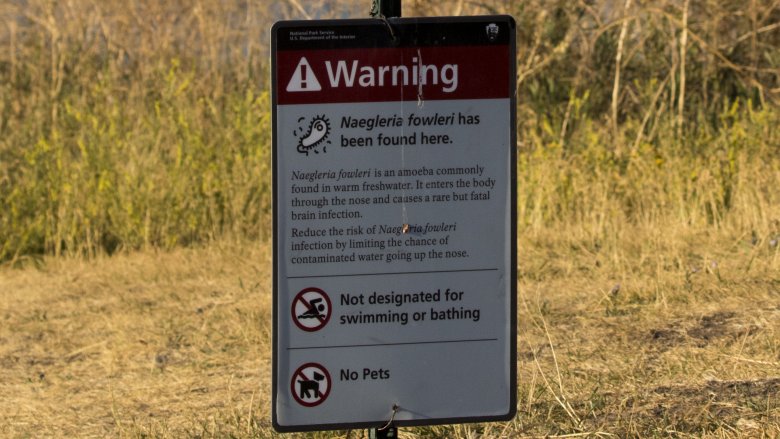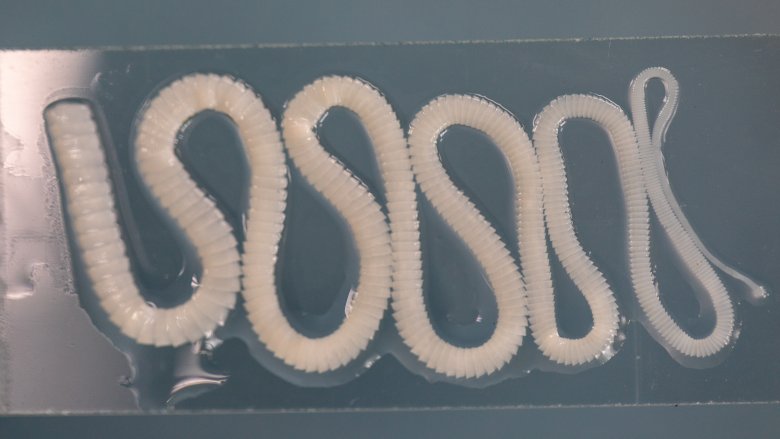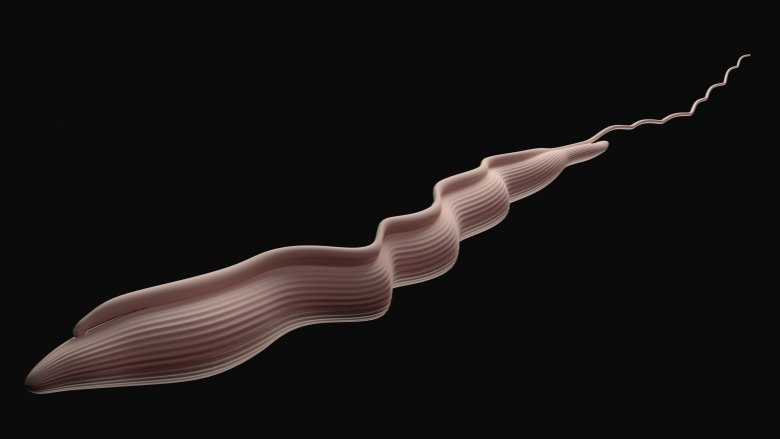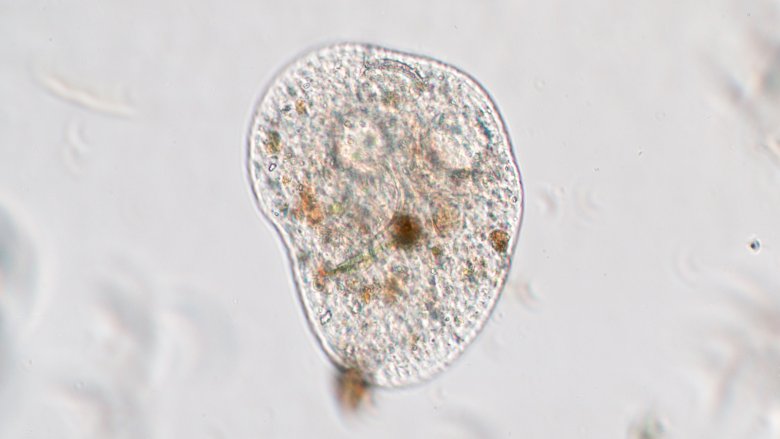Parasites That Can Control Human Brains
There's a reason why "I'm losing my mind" is such a popular saying. Few things are more terrifying than the idea of your thinking organ being taken away from you, because with that, you'd lose everything else as well. Imagine how horrendous it would be if there was some unseen parasite that could build its home in your brain and slowly but inevitably affect it in unpleasant ways. Now, you can stop imagining, because these parasites very much exist.
Of course, we're not talking about actual mind control. There are no zombifying parasitic organisms that can turn a human being into a mindless drone like this fungus does to ants ... at least, as far as we know. However, that doesn't mean that the human brain doesn't have more than its share of tiny creatures that can latch onto it and influence it in strange and often terrifying ways. Here's a look at them and their strange effects.
A parasite from your cat can change your brain in strange ways
Cat owners may have bumped into this one while reading about the nastier parts of how to care for their pet. The CDC describes Toxoplasma gondii as a single-celled parasite that infects over 40 million people in the United States alone, and you can get it from contact with cat feces, contaminated food and water, or mother-to-child transmission. Though most carriers have healthy immune systems that can keep the parasite at bay, Toxoplasma can be a terrifying thing for infants and people with weakened immune systems. For them, a Toxoplasma infection can turn into toxoplasmosis, which seems like a severe flu with muscle aches and pains, and can last for over a month. However, unlike regular flu, a severe toxoplasmosis can heavily damage the brain, eyes, and other organs. This can even be fatal, as seen in Trainspotting, where the drug addict Tommy dies after contracting toxoplasmosis from his kitten.
Toxoplasma gondii can mess with your brain in pretty odd ways. According to research by the University of Leeds, it may directly affect the production of dopamine, which can lead into neurological disorders such as ADHD, schizophrenia and Parkinson's disease. The Guardian reports that a Toxoplasma infection may also be able to turn its carriers into go-getters who are significantly more likely to start careers in business, management and entrepreneurship. Does this mean that capitalism is a literal disease that you can catch from cat feces? Research is ongoing.
A parasite that can make you forget how to walk
Sometimes, a brain parasite can lurk in your head for years before it wakes up and starts causing trouble. Live Science reports a particularly gruesome incident from 2018, when a 31-year-old New England man suddenly developed a headache and a fever, and started having trouble walking. The confused man went to the emergency room where the doctors took an MRI of his brain and made a horrifying discovery. There was a large (3.1 inches by 2.7 inches by 2.3 inches) mass in his brain. When they took a sample of it, they discovered that the strange growth was teeming with small organisms.
The man, who had emigrated from El Salvador six years before, had a brain infection caused by a parasite called Trypanosoma cruzi. The parasite is transmitted through bites from Latin American triatomine bugs, and causes a nasty, delayed infection called Chagas disease. The trouble with walking the man was experiencing was just one of the symptoms, which tend to be mostly flu-like at first, but can become chronic and cause awful complications even years later, up to and including heart failure.
The deadly amoeba that eats brains
If you were looking for a brain parasite that could carry a horror movie, Naegleria fowleri would probably be the best — or rather, worst — candidate. This isn't because it turns its carrier into a mindless zombie that hungers for brains. This parasite is arguably even worse, because it likes to cut out the middleman and personally eat the brain.
The CDC describes Naegleria as a type of amoeba that can be found in warm freshwater. When it comes across an unwary swimmer, it enters the body through the nose, and immediately heads for the brain. Once there, it slowly but steadily begins to destroy the host's brain tissue, leading to an infection known as primary amebic meningoencephalitis, which is essentially medical speak for "a tiny creature eating your brain from the inside." The infection has an astonishing fatality rate of 97 percent, and the host can experience a wide range of symptoms ranging from brain swelling, fever and vomiting to seizures and hallucinations, all before the practically inevitable death one to twelve days later.
According to Wired, Naegleria can creep into unwary noses wherever warm freshwater is found, such as Texas and Yellowstone National Park. Fortunately, it's relatively difficult to contract if you remember to keep your head above water. The infection it causes isn't contagious, and you can drink Naegleria-infected water without risk. Well, at least without any more risk than drinking strange water usually poses.
Exotic tapeworms can live in the brain and move around
Tapeworms are most usually associated with intestines, but some of them are more than happy to explore the more ... thoughtful avenues within the human body. The results can be just as creepy as you'd imagine. CNN reports an incident from 2013 in which doctors discovered a tapeworm from the brain of an English man. The patient had contracted the parasite on his visit to China, and it had actually been lounging inside his skull for a good while — he had experienced his first headaches four years before the tapeworm was discovered. At that time, his symptoms were misdiagnosed and treated as tuberculosis. However, when he returned years later with a completely different set of symptoms such as seizures and leg weakness, the doctors looked a little deeper, and discovered that the patient was actually infected with Sparganosis, a nasty case of worm-in-brain. The difference between the first and second round of symptoms was explained by the worm moving around the brain and pushing on different parts.
The parasite causing all the trouble was surgically removed and turned out to be Spirometra erinaceieuropaei, a mysterious and little-known tapeworm with a complicated life cycle, most commonly encountered in Asia. There's no telling how much trouble it could have caused to the man, either, because it was still quite young. In fact, the CDC says that this particular creature can live up to 20 years inside its host.
It turns out that rabies is a parasite, too
When we think of brain parasites, we tend to think about tiny critters that invade the skull and take over. The thing is, this description can also apply to viruses, such as rabies. According to Levi Morran from Emory University in Atlanta, Georgia, rabies is actually one of the more frightening parasites, because it doesn't discriminate between humans and other mammals.
As the National Organization for Rare Disorders describes, rabies is transmitted from the saliva of an infected animal, and the patient has between 20 and 60 days before it turns them into a different person. The first symptoms are deceptively like a pretty standard bad week — a feeling of unease, nervousness and depression, with a side order of flu-like symptoms and pain at the spot that was bitten or scratched. A few days later, things take a serious neurological turn. The most famous version is the "furious" state, where the patient becomes agitated and thrashes, chokes, and bites. A rarer version turns the patient sluggish and passive, eventually paralyzing them until they fall in a coma. Some patients alternate between the two stages. The icing on the horrible cake? Hallucinations and assorted cardiovascular effects that, according to WHO, will eventually lead to death from either fatal coma or cardio-respiratory failure.
Fortunately, rabies is a vaccine-preventable disease. It's mostly extinct in developed countries, and several health organizations have made it their mission to achieve zero human rabies deaths by the year 2030.
Parasite cysts in the brain cause epilepsy
There's a parasitic cestode known as Taenia solium, and according to Science Daily, it's so nasty that the condition it brings on is actually considered a major cause of epilepsy in developing countries. It's also nasty as in "extremely gross," because the parasite causes degenerating cysts to form in the brain. Apart from the epileptic symptoms, the parasite can also manifest in other, terrifying ways. Scientific American describes a case from 2010 where a Californian woman suddenly started growing weak and losing the feeling in her limbs, one by one. The doctors could not understand what was ailing her, and diagnosed the malady as both brain tumor and cancer before a CT scan finally revealed the calcified parasite lodged in her brain.
The condition is known as neurocysticercosis, and CNN reports that it can be contracted either by eating undercooked pork, or through contact with infected feces. Incidentally, that makes it possible for hosts to inflict the revolting brain parasite cysts on themselves. Because the Taenia parasite is a tapeworm, it can easily end up in the intestine. If the host isn't too careful about washing their hands after visiting the bathroom, the parasite that just left their body has a good chance to have a second go, and it might just decide to take the scenic route to the brain this time around.
An amoeba that can ruin the ability to speak properly
Balamuthia mandrillaris is a free-living amoeba that hangs around in the soil, just waiting for the chance to enter a body. According to the CDC, it can enter a host body if a skin wound or cut is in contact with the soil, or even if you breathe in some dust that contains the parasite. There's also a chance that the amoeba lives in water, because frankly, scientists know very little about it at this point.
After Balamuthia is in, it can surf the bloodstream all the way to the brain, where it will cause a serious infection called granulomatous amebic encephalitis, or GAE for short. The good news about GAE is that it's incredibly rare. The bad news is that the poor person who loses in the brain amoeba lottery is in serious trouble. At first, the host might experience mild fever, nausea, head and neck pain, tiredness and light sensitivity. Eventually, the symptoms get more serious, and the host starts to lose their ability to speak in full sentences and walk properly. Seizures, weight loss, changes in behavior and even partial paralysis are also to be expected.
The death rate of a Balamuthia infection can be up to 89 percent, although chances of survival improve if it's diagnosed and treated early on. Unfortunately, the generic initial symptoms mean that the parasite is extremely hard to diagnose until the patient is so close to death that nothing can be done.
A parasite that causes fatal sleep sickness
Sleeping sickness sounds like an excuse a lazy student might give to the teacher, but for 36 African countries south of the Sahara, it's a very real problem. According to the WHO, the official name of the disease is human African trypanosomiasis, and it's caused by a protozoan parasite called Trypanosoma brucei. This particular parasite isn't content just hanging around in expired food or a muddy puddle. Instead, it actively seeks out targets through its initial hosts, tsetse flies.
When an infected fly bites a human, the Trypanosoma is in — and sleeping sickness is on. There is a rare and acute form of the disease that can run its course in mere weeks, but the most common version can take several years to develop as the parasite slowly makes its way from the blood to the central nervous system. Whenever sleeping sickness chooses to manifest, its most famous (but far from the worst) symptom is the disturbed sleeping cycle that gave it its popular nickname. Over time, an untreated patient may experience sensory disturbances, psychiatric disorders, coordination problems, and seizures before ultimately falling into coma and dying. Although properly diagnosed and treated patients do have a fairly good chance of surviving the disease, even treating sleeping sickness in its latter stages is difficult, because the drugs needed to cross the blood-brain barrier and reach the parasite are toxic and tricky to administer.
A horse brain parasite that can shut down the human body
When you hear that a parasite normally affects horses, you really, really don't want the next sentence to begin with a "however." Unfortunately, that's very much the case when it comes to Halicephalobus gingivalis. NCBI tells us that it's a type of roundworm that lives in manure, water, soil, and decomposing matter. Science is not quite sure how it spreads, but one thing is certain: it occasionally affects horses, zebras, cattle, certain types of sheep, and of course, humans.
Halicephalobus symptoms can be anything from minor lesions to the parasites aggressively spreading through a number of organs, from brain to kidneys and spinal cord. The worse end of the spectrum is enough to take down a horse, and in the rare case that the parasite targets a human host, the results can be grim. One study from 2013 describes the case of a 65-year-old lady from Florida, who went to see a doctor about a urinary tract infection. However, more and more symptoms started to develop, and she started to lose her mental faculties. By the fifth day, she was comatose and could not breathe by herself. Two weeks after the first symptoms, she was dead. Every diagnosis and attempt to treat her had been futile, and only an autopsy revealed that her brain and a few other organs were infested with parasitic worms.
The amoeba that will slowly ruin everything
When an amoeba comes to visit the human body, it's usually not the type of guest to bring a tasteful bouquet of flowers and a carefully selected bottle of wine. Acanthamoeba is no exception. According to the CDC, this parasite enjoys warm water and entering the body through skin wounds, nostrils, or even hitching a ride from the carrier's contact lenses. Depending on its point of entry, it can cause a number of problems to the host's skin, eyes, spinal cord, and brain.
Most of these problems are painful, annoying and embarrassing rather than fatal, but in the extremely unfortunate occasion that Acanthamoeba gets to the brain, all bets are off. At that point, the host is looking at a whole bunch of awfulness, including (but not limited to) lack of attention to people and surroundings, loss of balance and bodily control, seizures, and hallucinations. If it gets to that point, there is very little modern medicine can do, because while the eye and skin infections caused by the parasite tend to be treatable, the CDC readily admits that most cases of brain and spinal cord infection with this particular parasite are fatal.
Raccoon roundworm is a fatal souvenir for the brain
What's the worst thing that a raccoon can give to a human being? A ravaged trash can? A nasty bite, if you venture too close? Or maybe an even nastier parasite? Of course, it's that last one. According to researchers from the University of Utah, the raccoon roundworm is a common "trash panda" parasite that can grown to the size of a pencil, and can produce over 100,000 eggs every day. Every single one of those eggs is extremely hard to kill, and can survive for over a year. This means that in places like Santa Barbara, California, where an estimated 90 percent of the raccoon population is infested with the parasite, every surface that they touch is positively sprinkled with these ultra-resilient parasite eggs. As a result, a study has shown that roughly 7 percent of the area's human population tests positive for raccoon roundworm antibodies ... which means that their bodies have had to deal with the parasite.
This is no laughing matter, because science still has no clue how the raccoon roundworm typically affects human hosts. We do know, however, that when the parasite reaches the host's brain, it will go absolutely medieval. The infection it causes is called baylisascariasis, and there are dozens of known cases where it has caused severe brain damage or blindness in humans, adult and child alike.
Even influenza can become a brain parasite
One of the most deadly parasitic outbreaks happened in 1918, when a vast pandemic swept the world and killed an estimated 500 million people, which was a third of the world's population at the time. The deadly parasite that caused such incomprehensible destruction was none other than the influenza virus. Yes, respectable institutions such as the Journal of the Royal Society of Medicine classify influenza as a parasite.
But how does the flu affect the brain, apart from feeling like it fills your entire head with fever and mucus? According to a study published in the Annals of Epidemiology in 2010, it might actually make us more sociable. When researchers exposed test subjects to influenza virus (fortunately, the exposure was done with vaccinations, instead of the 1918 way), they discovered that the virus made people interact with significantly more people and in larger groups than they had done before exposure. Although the researchers noted that the findings are far from conclusive and further investigation is needed, it's pretty horrifying to imagine that the influenza virus might sneakily tweak our brain into hanging out with tons of people instead of just sitting at home ... and thus, help the virus spread before our own symptoms kick in.












